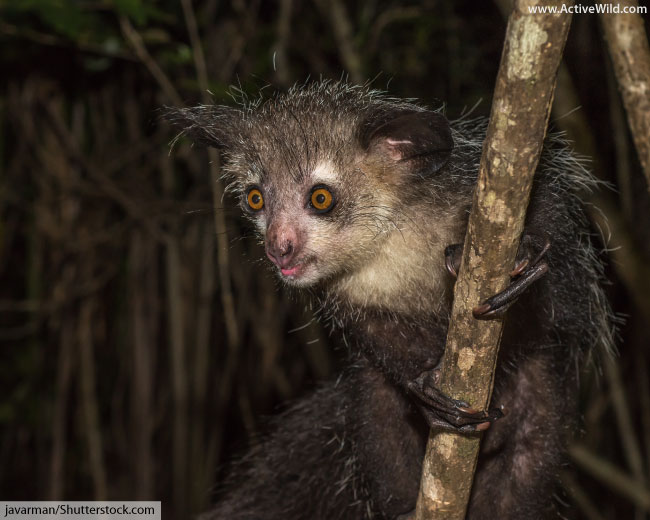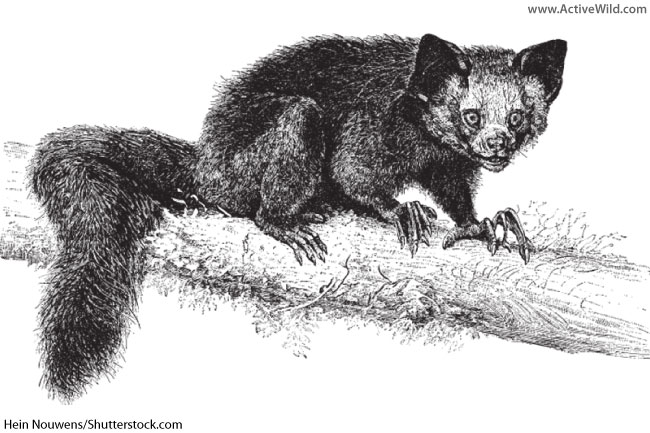Aye-aye facts, pictures, video and information. The aye-aye, a unique lemur native to Madagascar, is a fascinating animal shrouded in mystery and superstition. Characterized by its distinctive features, including large, bat-like ears and a long, thin middle finger, the aye-aye has adapted remarkably to its nocturnal lifestyle.
One of the strangest aspects of the aye-aye's lifestyle is the way in which it hunts; it is thought to be the only primate that uses echolocation to find food. By tapping on tree trunks with its bony finger, it can tell if there is food hidden under the bark.
Read on to find out more about this bizarre rainforest animal...
Aye-Aye Facts At A Glance
- Scientific name: Daubentonia madagascariensis
- Type of Animal: Mammal, Primate
- Animal Family: Daubentoniidae
- Where Found: Madagascar
- Head-Body Length: 30 to 40cm (12 to 15in)
- Tail Length: 56 to 61cm (22 to 24in)
- Weight: 2 to 2.7kg (4 to 6lbs)
- Conservation Status: Endangered
- Other interesting aye-aye facts: Relative to body size, the aye-aye has the biggest brain of any lemur.
Meet The Aye-Aye: Introduction

The aye-aye is one of the world's most unique / weird (take your pick) primate species. It's the largest nocturnal primate and the only one to use echolocation to find food.
Echolocation is a biological sonar used by certain animals to navigate and/or hunt by emitting sound waves and listening for their echoes to determine the location and size of nearby objects.
The aye-aye is a lemur, and the only species in the family Daubentoniidae.
Lemurs are a diverse group of arboreal primates endemic to Madagascar, known for their large eyes, long tails, and varied social and feeding behaviors.
Because of the aye-aye's unusual mix of characteristics – a squirrel-like tail, rodent-like teeth, cat-like facial features, and a highly adapted bony middle finger – there was some doubt over what type of animal it was after its discovery.
(You can see a close-up view of the aye-aye's strange bony middle finger further down the page.)
The aye-aye is only found on Madagascar, an African island situated in the Indian Ocean off the east coast of the continent.
Many Malagasy people think that it's a bad omen to see an aye-aye. This has led to the species being deliberately hunted.
What Does The Aye-Aye Look Like?
Watch the video below to see this weird animal in the flesh!
The aye-aye has a shaggy black or dark brown coat that is rough in texture. Its tail is long and bushy.
The aye-aye's triangular face is dominated by its large, piercing orange eyes. Its sharp teeth grow continuously throughout its lifetime.
Large, rounded ears positioned at the sides of the aye-aye's head are able to rotate towards the source of a sound. Special ridges are present on the inner surfaces of the ears. These are adaptations for picking up echoes as the animal forages for grubs using its unique 'finger tapping' method, which we'll find out more about further down the page.
The aye-aye's fingers are long and have sharp, pointed claws. The bony middle finger of the fore paws is noticeably thinner than the others. Like the human shoulder, it has a ball-and-socket joint, giving it a wide range of movement.
Where Is The Aye-Aye Found?
The aye-aye occurs in low densities almost across all of Madagascar, although the population is most concentrated along the eastern coast.
You can see where Madagascar is situated on the map below. Zoom in for a closer look!
Aye-Aye Habitat
The aye-aye is a reasonably adaptable species and occurs in all habitats on the island except for the southern spiny desert. It prefers dense forest habitats with plenty of cover, and is most often found in tropical and coastal rainforest.
Other habitats in which the aye-aye is found include bamboo thickets, mangrove swamps, dry scrub forest and even cultivated areas such as coconut groves.
The aye-aye typically lives at altitudes above 700m (2,300ft), but has been seen from sea level up to 1,875m (6,150ft).
Aye-Aye Behavior

The aye-aye is nocturnal (active at night) and arboreal (tree-dwelling). During the day, it sleeps curled up in a ball-like nest made out of leaves, vines and branches.
An aye aye will usually use the same nest for several days before moving on. Several aye-ayes may use the same nest at different times.
The aye-aye is territorial, and both sexes establish home ranges that are marked with scent. Male territories are large – up to 320,000 m2 (80 acres) – and often overlap with each other. The smaller female territories are typically found within that of at least one male.
The species has a solitary lifestyle, although male aye-ayes sometimes forage and travel in groups of up to 4 individuals.
Aye-Aye Life Cycle
Unlike other lemurs, the aye-aye doesn't seem to have a strict mating season. Estrus (the female's readiness to mate) lasts 3 to 9 days, during which time the female calls repeatedly to attract a mate.
This can result in the arrival of several males, who will compete for the female and attempt to guard her from the others. The female may mate with more than one of them.
After a gestation period of about 5 months, the female gives birth to a single infant weighing 90 to 140g (3.2 to 4.9oz). The young aye-aye is able to communicate with its mother using vocalizations from birth.
The infant stays in the nest for the first 2 months of its life and is weaned at 7 months of age. It stays with its mother until around 2 years old, after which time it leaves to establish a territory of its own.

What Do Aye Ayes Eat?
The aye-aye is an omnivore that eats seeds, fruit, nectar, mushrooms and insect larvae. It spends up to 80% of the night searching for food in the canopy.
How The Aye Aye Finds Food Using Echolocation
Between 5 and 41% of the aye-aye's foraging time is spent on a behavior called 'percussive foraging'.
This involves the aye-aye tapping rapidly at a tree trunk or a branch with its bony middle finger. As it taps it listens to the resultant echoes. From these is able to detect the hollow chambers created by wood-boring grubs within the tree .
When the aye-aye successfully locates its prey, it chews a hole into the wood with its sharp teeth and slips its thin middle finger under the bark to draw the grub out. The versatile middle finger is also used to scoop out the flesh of coconuts and other fruit.
Below is a close-up view of the aye-aye's highly-adapted middle finger:

Aye-Aye Predators
The aye-aye lives a secretive life high up in the trees, and has few natural predators. The Fossa (Cryptoprocta ferox) is known to prey on aye-ayes, and the young are vulnerable to attacks from both snakes and birds of prey.
Is The Aye-Aye Endangered?
Like many lemurs, the aye-aye is rated 'Endangered' by the IUCN.
Although the actual population size of the species is unknown, it is estimated that the population has declined by more than 50% over the last 3 generations, and is likely to continue to decline.
The most serious threats to the aye-aye include:
- Habitat loss: Deforestation is the biggest threat to the aye-aye. Its forest habitat is shrinking due to the expansion of farmland and human settlements as well as the harvest of ebony and other valuable hardwoods.
- Hunting: In many places in Madagascar, the aye-aye is persecuted because of superstitious beliefs about the animal. In other areas, the species is hunted for food or as a crop-pest of coconuts and other cultivated plants.
Aye-aye Facts: Related Pages
- Discover more weird and wonderful animals here: A to Z Animals
- Find out about more rainforest animals: Rainforest Animals List
- Learn about mammals: Mammals: The Ultimate Guide
- Become an animal expert: Animals: The Ultimate Guide To The Animal Kingdom



WOW SO COOL!!!
The middle finger thing is soooo weird?!! gave me the ick…
thanks for the super cool facts!
Hi Jon,
Glad you think so!
this is very helpful.
wild and weird!!!!!!!